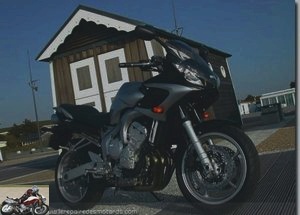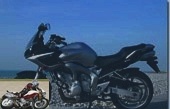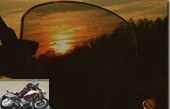Menus
- The GT roadster
- Discovery
- In the saddle
- Contact
- City
- Highway
- Departmental
- Comfort
- Braking
- Night
- Convenient
- Consumption
- Conclusion
The GT roadster
The Fazer has been completely revised for its edition
2004, Euro2 standard obliges. In fact, the new model has nothing
to do with its predecessor as the name: design,
engine, frame, everything has changed … for more tourism in the version
S.

Only the concept remains: a streamlined roadster equipped with a
sports engine, the R6 instead of the Thundercat as before.
In the end, the Fazer gained a powerful 123 horsepower engine.
of which she however kept "only" 98 horses.
And the concept benefits from the latest technologies
: die-cast aluminum frame, 4 dual jet injectors
steering, 32-bit processor, eccentric pulley butterflies,
vertical intake, catalyzed exhaust Euro2 standard…
In the end, the new model is 7 kilos less than the old one
and is in the featherweight of the category with only
180 kilos dry.
Discovery
 This
This
new Fazer gives the old model a big boost
and especially the competition.
We find him an Italian inspiration and some similarities with
CT or even Bulldog. In any event, the work
of design is magnificent. The 4-2-1 with the double exit under the saddle
is particularly the most beautiful effect, framing an aesthetic taillight.
As for the finish of the bike, it is perfect, down to the smallest
details, with a perfectly hidden electrical harness
and sheathed behind the headlight optics. The quality
is at the rendezvous.
In the saddle
 |
 |
 |
The motorbike is lower than the view at
priori; the saddle is actually only 790 mm. The feet
thus touch ground for the pilot of 1.70 m. The position is typical roadster,
with a wide, flat curved handlebars. The legs fit perfectly
the tank without hanging any roughness.
The bubble appears wide and high, especially compared to the model
previous and competing streamlined roadsters.
Under the eyes, we discover the central counter fully
digital, surrounded by the tachometer. Nothing is missing even the accessory
: totalizer, partial double trip, independent reserve trip,
clock, digital tachometer reminder, gauge
gasoline, oil temperature … as well as all the warning lights
: oil, injection, neutral, warning, full headlight … At night, the speedometer
is colored in a very legible South Sea blue.
The mirrors are easily adjusted and offer a wide
very comfortable field of vision.
Contact
 |
 |
The odometer resets itself showing its ‘possible’ 299 km / h
and the four cylinders snort in a very soft growl
discreet.
Clutch, start … the gears engage in such a way
neat and clean. The grip is immediate with a position
perfectly natural, straighter and hands wider apart
than on a roadster like the Suzuki Bandit.
City
If the first two reports are incisive, the Fazer agrees to leave
in all gears, even at the lowest engine speeds. The climb
in regime is particularly regular and
it is necessary to seek the nuance to feel its best mode and its
maximum torque. In the end, the Fazer does not surprise, except on the first
reports where the right handle must remain modulated
and progressive.
Lightweight and well-balanced, the Fazer weaves its way through
everywhere without any particular effort. The position allows you to stay in your
go through traffic jams, without any fatigue.
What will surprise in slow maneuvers is the large steering angle
(70 °) which allows you to make a half-turn in a pocket square
or almost and effortlessly.
The dry saddle and suspension will just prevent
cobblestones or deformed pavements. On the other hand,
the Fazer is unperturbed when it comes to driving, even
on grooved pavement.
Highway
The Fazer takes off on the motorway like a long-distance runner. The climb
in regime is done quietly or frankly and
it is possible to maintain a cruising speed of 150 km / h
no problem.
Beyond that, we tend to slip behind the bubble
but at 160 km / h, eddies generate vortices
unpleasant to the head. The technique consists
so rather to straighten up so that these whirlpools fall
rather on the shoulders and it is then possible to do
climb the counter easily.
It is therefore possible to drive quietly at a faster pace.
higher than indicated, especially since nothing
wiggles even in fast curves. The framework remains rigorous and the
impeccable course keeping even though the license was long overdue.
Departmental
 the
the
return to departmental is done without real surprise.
The Fazer adapts perfectly to the rhythm imposed by its pilot,
sometimes rolled up on the last gear or higher in
turns on an intermediate gear.
That said, the motorcycle does not encourage arousal, even if it
is able to keep the dragee high on multiple roadsters.
Because past the bar of eight thousand turns, the growl is transformed
roaring and you have to hang on to the handlebars. The 600 cc reveals
then really its 98 horsepower that it is not necessary
to whip at 14,000 rpm to derive pleasure and sensations.
Comfort
 The
The
saddle appears thin, long and comfortable. She reveals herself
as uncomfortable as possible quite quickly. Pilot and passenger shout
thanks after two hundred kilometers.
The passenger footrests are a little high for
the latter causing a little tension and the need to stretch
legs.
One could have feared that the heat of the exhausts under the
saddle warms the passenger? in the end, it is not.
Braking
The first impression of the rear brake is to be
spongy. No matter how hard we press, it doesn’t really react
and then suddenly it brakes hard.
A short try might make him hate it but you get used to it
in fact by using the front brake more intensively and
the latter is particularly powerful.
The Fazer is also very stable and sinks
very little on heavy braking … which tends to
to make the rear take off in a sensitive way…
or more depending on how you grasped the
brakes. In any case, she probably wins a palm
braking level for a 600 "roadster".
Night
Compared to the previous vintage, the Fazer made
hard work and now offers correct night lighting.
Convenient
There is no place under the passenger seat, because of the exhaust
under the saddle precisely.
 It
It
is still possible to place the tool kit and
a small-format U-type lock (like the France Antivol Stark Plus)
but no more under the rider saddle. But there’s no place for one
rain pants then.
On the other hand, it will be possible to place saddlebags
without fear of melting them on a pot.
The large metal tank allows for a large
magnetic bag without any problem.
The passenger handles are placed laterally
and are ideally placed for the passenger.
The central stand turns out to be close to the stand
sideways and a little hindrance for the crutching, which
it is the lateral or the central. At the central level,
the Fazer goes on central with disconcerting ease.
A point that will delight beginners and small riders often
hesitant to put the bike on central.
Consumption
The injection works wonders here with an average consumption of 5
liters per hundred in quiet use or at steady speed
130 km / h.
The reserve can therefore turn on only after the 300
km in normal driving: city, county, motorway mix
at a steady pace. This motorcycle is a real camel,
despite a reduced tank to 19 liters.
With a sportier ride, higher in the laps or at
high speed on the motorway, it can exceed
the six liters where other roadsters greedily swallow
from eight liters to a hundred.
Conclusion
 Change
Change
a successful model is always a challenge. Yamaha succeeded here
his bet by offering a new aesthetically successful Fazer,
pleasant to drive and particularly versatile.
We may regret that its motor character is more
marked and powerful makes it more difficult to grip for
a beginner than his predecessor.
In return, this more linear power remains very
controllable and offers the advantage of a motorcycle capable of aging well
with his pilot without tiring him as it could have happened before.
Strong points
- versatility
- braking
- consumption
Weak points
- comfort
Competitors: Honda Hornet 600, Suzuki
Bandit 600 S, Triumph Speed Four
The technical sheet | Your
reactions on the forum
Related articles
-
Triumph Sprint ST 955i motorcycle test
Long-distance Sport-GT The Sprint ST is one of those road cars with a zest sporty, allowing long journeys to be combined with thrills day by day. And…
-
Triumph Tiger 1050 motorcycle test
A 4-day trial over 1,100 km The Triumph Tiger had taken a sacred look of old over the years, especially compared to the new Varadero and VStrom, despite…
-
Honda CB650R and CBR650R motorcycle comparison test
Beneficial Redesign for the roadster and the streamlined roadster become sporty ? Engine and cycle parts optimized for the two 2019 Honda vintages Based…
-
The scooter missing between 250 and 530 cm3 in tune XMax 125, XMax 250, TMax 530…. one could have imagined that Yamaha would go hunting on the roads of…
-
Triumph Daytona 675 motorcycle test
After several sports trials 4 cylinders in 600 cm3 (TT 600 then Daytona 600), Triumph gives up to reveal finally a sports 600 based on a 3 cylinder: the…
-
Honda Hornet 600 – CB600F 2007 vintage motorcycle test
Ten-day test of the 2007 vintage Exit on the heels of the wicked roadsters ago more than 9 years, the CB600F Hornet has been completely revised in 2007….
-
Honda NC 700 S motorcycle test
Crisis solution Honda revives the basic motorcycle with its NC 700 S: a floor price, practical aspects borrowed from the scooter and consumption at the…
-
125, 390, 690, 990, 1290 and now 200! KTM does not stop declining its flagship roadster, this time with this small displacement of 200 cm3. Made in India…
-
KTM 890 Duke R motorcycle test
R for Revolution, the circle has come full circle Parallel twin of 890 cm3, 121 hp, 99 Nm, 166 kg dry, 11,900 euros We no longer present the KTM Duke,…
-
Triumph Street Triple 765 RS motorcycle test
The Moto2 roadster 3-cylinder engine, 765 cc, 123 HP, 79 Nm, 166 kg dry, € 11,900 Since its release in 2007, the Street Triple has been a real commercial…